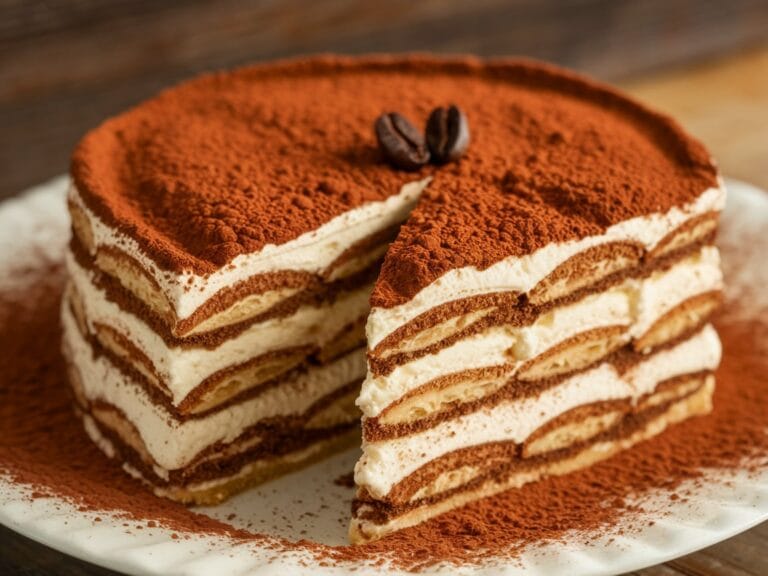Tiramisu is an Italian dessert known for its indulgent layers of coffee-soaked ladyfingers and creamy filling. At the heart of this iconic treat lies one key ingredient: the cheese. Traditionally, mascarpone has been the go-to choice, but some variations substitute ricotta. This substitution raises the question: which cheese is truly better for tiramisu? Let’s break down the key differences between mascarpone and ricotta in terms of texture, flavor, and nutritional value to help you decide which cheese works best for your tiramisu.
Understanding Mascarpone and Ricotta: Origins and Characteristics
To make an informed decision about which cheese is better for tiramisu, it’s essential to understand the background of both mascarpone and ricotta.
- Mascarpone: This creamy Italian cheese originates from the Lombardy region. Made by curdling cream with acid, mascarpone has a smooth, buttery texture and a fat content of up to 55%. Its subtle sweetness makes it ideal for use in desserts like tiramisu. Its high-fat content is what gives tiramisu its luxuriously creamy texture.
- Ricotta: In contrast, ricotta, which means “recooked” in Italian, is made from leftover whey, the liquid remaining after the production of other cheeses like mozzarella. Ricotta is lighter, with a fat content of 10-15%, and has a grainier, fluffy texture. It has a slightly tangy flavor, often used in both savory and sweet dishes. Though ricotta is widely used in desserts such as cannoli, its texture may not suit the traditional creaminess desired in tiramisu. For those interested in lighter dessert options, ricotta can also be featured in simpler, healthier recipes like pumpkin banana loaf.
Nutritional Comparison: Which Cheese is Healthier?
When choosing between mascarpone and ricotta for tiramisu, health considerations may play a significant role. While mascarpone offers unmatched richness, ricotta stands out for its lower calorie and fat content, making it a healthier option.
- Mascarpone:
- 429 calories per 100g
- 42g of fat per 100g
- Lower protein content compared to ricotta
- Contains about 110mg of cholesterol per 100g
- Ricotta:
- 174 calories per 100g
- 13g of fat per 100g
- Higher protein content (11.26g per 100g)
- Good source of calcium with 207mg per 100g
If you’re looking for a more health-conscious version of tiramisu, ricotta offers fewer calories and more protein, making it a viable alternative. However, if you’re indulging for a special occasion, the richness of mascarpone may be worth the extra calories.
Texture and Flavor: The Deciding Factors
One of the most critical aspects when choosing between mascarpone and ricotta for tiramisu is texture. Tiramisu is renowned for its velvety, smooth cream layers, which mascarpone delivers effortlessly.
- Mascarpone: The smooth, creamy texture of mascarpone blends seamlessly with whipped cream and sugar, creating a perfectly rich layer between the coffee-soaked ladyfingers. Its buttery, mildly sweet flavor balances the bitterness of espresso and the sweetness of cocoa powder and sugar, contributing to tiramisu’s unique flavor profile.
- Ricotta: Ricotta, while flavorful, has a grainier texture, which can be more challenging to blend into the silky smooth consistency tiramisu requires. The slightly acidic taste of ricotta can also alter the traditional flavor of tiramisu, giving it a lighter, less indulgent feel.
If texture is important to you, mascarpone is the better choice as it maintains the classic smoothness that defines tiramisu. However, if you’re looking for a variation with a lighter feel, ricotta can work, especially if blended until smooth.
Why Mascarpone is the Traditional Choice for Tiramisu
The use of mascarpone in tiramisu dates back to its origins, and there are several reasons why it remains the classic choice for this dessert:
- Creamy Texture: Mascarpone is integral to achieving the silky smooth layers that melt in your mouth when eating tiramisu. Its rich consistency ensures that each layer of cream complements the coffee-soaked ladyfingers without becoming too runny or too firm.
- Balanced Flavor: The subtle sweetness and richness of mascarpone enhance the dessert’s overall flavor, working in harmony with the espresso, cocoa, and sugar to create a perfect balance of bitterness and sweetness.
- Consistency: Because mascarpone is so easy to work with, it creates a consistent, luxurious cream layer every time. If you’re looking for more indulgent dessert ideas, you might enjoy learning how to make the ultimate hello brownie recipe, another rich and satisfying treat.
Can You Use Ricotta in Tiramisu?
For those looking to create a lighter version of tiramisu, ricotta can be used, but it may require some tweaks to the recipe.
- Blending Ricotta for Creaminess: Ricotta’s grainy texture can be smoothed out by blending it with a bit of heavy cream or butter, which helps achieve a texture closer to mascarpone. This can create a lighter yet still enjoyable cream layer.
- Using a Ricotta-Mascarpone Blend: Some bakers opt for a mix of ricotta and mascarpone to combine the best of both worlds. The mascarpone adds richness, while the ricotta lightens the overall calorie load.
While using ricotta will result in a different texture and flavor, it’s a great option for those who want a less calorie-dense tiramisu without sacrificing the creaminess entirely.
Expert Opinions on Mascarpone vs Ricotta for Tiramisu
Culinary experts and chefs widely recommend mascarpone for tiramisu because of its silky texture and rich flavor. Most agree that mascarpone is the best choice for an authentic tiramisu that maintains the traditional balance of flavors. However, some home bakers enjoy experimenting with ricotta to create lighter, healthier versions of tiramisu. If you’re curious about more ways to modify traditional recipes, you might want to explore desserts like earl grey cookies, which offer a sophisticated twist on classic treats.
Health Considerations: Choosing Based on Diet
Choosing between mascarpone and ricotta may come down to personal dietary preferences. Here are some considerations to help guide your choice:
- Choose Ricotta if:
- You want a lighter, lower-fat version of tiramisu.
- You’re looking for a higher-protein option that is more health-conscious.
- Choose Mascarpone if:
- You want the traditional, rich, and creamy tiramisu experience.
- You’re preparing tiramisu for a special occasion and are not concerned about calories or fat content.
Final Verdict: Which Cheese is Better for Tiramisu?
Ultimately, deciding between mascarpone and ricotta for tiramisu depends on your priorities.
- If you want to stick to authenticity and crave a rich, indulgent dessert, mascarpone is the clear winner. Its smooth texture, balanced sweetness, and high-fat content make it the ideal choice for classic tiramisu.
- If you’re looking for a healthier, lighter version of tiramisu, ricotta can work as a substitute, but expect a slight change in texture and flavor. Blending ricotta with cream or butter can help mimic the creaminess of mascarpone, though it won’t provide the same indulgent consistency.
Whether you choose mascarpone or ricotta, both cheeses offer unique qualities that can complement different versions of tiramisu. For an authentic experience, stick with mascarpone, but for a lighter twist, ricotta may be worth a try.
FAQs
- Can you substitute ricotta for mascarpone in tiramisu?
Yes, but it will result in a lighter, grainier texture unless blended thoroughly. Combining ricotta with cream can help smooth out its texture. - What is a good alternative to mascarpone if I can’t find it?
Cream cheese or a mix of ricotta and heavy cream can be used as a substitute, though the flavor and texture will vary slightly. - Is tiramisu healthier with ricotta or mascarpone?
Tiramisu made with ricotta is lower in calories and fat, making it a healthier option. However, it will have a lighter, less indulgent texture than mascarpone-based tiramisu. - Why is mascarpone the traditional choice for tiramisu?
Mascarpone’s smooth texture and rich flavor make it the perfect base for tiramisu’s creamy layers, enhancing the dessert’s signature flavor and texture.
In conclusion, while both mascarpone and ricotta can be used to make tiramisu, mascarpone remains the better choice for those seeking the classic, luxurious experience. If you’re aiming to lighten things up, ricotta can be a good alternative, especially when blended to improve texture.
Print
Is mascarpone or ricotta better for tiramisu?
Tiramisu is an Italian dessert known for its indulgent layers of coffee-soaked ladyfingers and creamy filling. At the heart of this iconic treat lies one key ingredient: the cheese. Traditionally, mascarpone has been the go-to choice, but some variations substitute ricotta. This substitution raises the question: which cheese is truly better for tiramisu? Let’s break down the key differences between mascarpone and ricotta in terms of texture, flavor, and nutritional value to help you decide which cheese works best for your tiramisu.
- Total Time: 4 hours 20 minutes
- Yield: 6-8 servings 1x
Ingredients
- 1 cup strong brewed espresso (cooled)
- 3 tablespoons rum (optional)
- 3 large eggs (separated)
- 1/3 cup granulated sugar
- 1 cup mascarpone cheese (or ricotta for a lighter version)
- 1 cup heavy whipping cream (whipped to stiff peaks)
- 24 ladyfingers (savoiardi)
- 2 tablespoons unsweetened cocoa powder
- Dark chocolate shavings (optional for garnish)
Instructions
- Prep Espresso Mixture:
Brew 1 cup of espresso and let it cool. Add rum if using and set aside. - Prepare Cream Base:
In a mixing bowl, whisk egg yolks and sugar until thick and pale. Add mascarpone (or ricotta) and mix until smooth. - Whip Cream:
In another bowl, whip the heavy cream until stiff peaks form. Gently fold the whipped cream into the mascarpone mixture. - Beat Egg Whites:
In a separate clean bowl, beat the egg whites until stiff peaks form. Gently fold the beaten egg whites into the mascarpone mixture to create a light, fluffy cream. - Assemble Tiramisu:
Dip each ladyfinger into the espresso mixture for a few seconds and arrange in a layer in your serving dish. Spread half of the mascarpone cream over the ladyfingers. Repeat with another layer of dipped ladyfingers and finish with the remaining mascarpone cream. - Chill:
Refrigerate the tiramisu for at least 4 hours (preferably overnight) to let the flavors meld. - Serve:
Before serving, dust the top with unsweetened cocoa powder and garnish with chocolate shavings if desired.
- Prep Time: 20 minutes
- Cook Time: 4 hours (minimum)
- Category: Dessert
- Method: No-bake, Chilled
- Cuisine: Italian
- Diet: Vegetarian
Keywords: tiramisu recipe, mascarpone tiramisu, ricotta tiramisu, classic tiramisu, no-bake tiramisu, easy tiramisu, Italian dessert, best tiramisu




